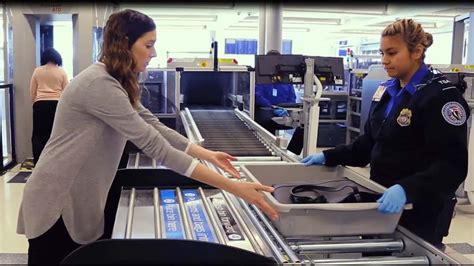
Travelers must now declare all electronic devices larger than a cell phone at TSA checkpoints, according to updated regulations. This includes laptops, tablets, e-readers, and gaming consoles, which must be removed from bags and placed in separate bins for screening, aiming to improve security and streamline the screening process.
The Transportation Security Administration (TSA) has quietly implemented a stricter policy regarding the screening of electronic devices, requiring passengers to declare all electronics larger than a cell phone at security checkpoints. The updated rules mandate that these devices – which include laptops, tablets, e-readers, cameras, and handheld gaming consoles – be removed from carry-on bags and placed in individual bins for X-ray screening. The move is intended to enhance security measures by providing TSA officers with a clearer view of the contents of passengers’ carry-on luggage and to reduce instances of bags needing to be manually searched due to obscured objects.
“TSA is committed to using the best technology and procedures to ensure that passengers are safe and secure,” stated a TSA spokesperson. “By requiring passengers to place larger electronic devices in separate bins, we can get a clearer X-ray image of the bag and reduce the need for secondary screening.”
The change has already been rolled out at airports nationwide, and while there was no formal announcement, travelers are discovering the new requirements as they navigate security lines. This proactive approach aims to mitigate potential threats by allowing TSA officers to examine electronic devices more thoroughly. The agency believes that separating electronics will significantly improve threat detection capabilities and reduce the number of alarms triggered by cluttered bags.
The policy update reflects the TSA’s ongoing efforts to refine its security protocols in response to evolving threats and technological advancements. By focusing on improving the clarity of X-ray images, the agency aims to minimize disruptions to travelers while maintaining a high level of security.
Background and Justification
The decision to implement this policy stems from a number of factors, including the increasing sophistication of electronic devices and the potential for concealing threats within them. TSA officials have long been concerned about the possibility of explosives or other dangerous items being hidden inside laptops, tablets, and other electronics.
Previously, passengers were only explicitly required to remove laptops from their bags for screening. However, the new policy expands this requirement to include a wider range of devices, reflecting the agency’s assessment of potential risks.
The TSA has been testing enhanced screening procedures for electronic devices for several years, using advanced imaging technology and other methods to improve threat detection. The current policy is a refinement of these earlier efforts, based on data collected from pilot programs and operational experience.
“We are constantly evaluating our security procedures and making adjustments as necessary to stay ahead of evolving threats,” explained a senior TSA official. “This new policy is a direct result of our ongoing efforts to improve security and efficiency at airport checkpoints.”
The enhanced screening process is designed to address several key security concerns:
- Improved X-ray Clarity: Placing electronic devices in separate bins allows TSA officers to obtain clearer X-ray images of the devices and the contents of the bag. This reduces the likelihood of obscured objects and minimizes the need for manual searches.
- Enhanced Threat Detection: By examining electronic devices more closely, TSA officers can better identify potential threats, such as explosives or concealed weapons.
- Reduced False Alarms: Separating electronics can help reduce the number of false alarms triggered by cluttered bags, streamlining the screening process and minimizing delays for passengers.
Impact on Travelers
While the new policy is intended to improve security, it also has implications for travelers. Passengers should be prepared to remove all electronic devices larger than a cell phone from their carry-on bags and place them in separate bins at the security checkpoint. This may require some additional time and effort, particularly for those who are not aware of the new requirements.
To minimize delays and ensure a smooth screening process, travelers are advised to:
- Familiarize themselves with the new policy: Before arriving at the airport, passengers should review the TSA’s website or other reliable sources for information about the updated screening procedures.
- Pack strategically: Passengers should pack their electronic devices in an easily accessible location in their carry-on bags to facilitate removal at the security checkpoint.
- Arrive early: Passengers should allow themselves extra time at the airport to account for the possibility of longer security lines due to the new screening procedures.
- Cooperate with TSA officers: Passengers should follow the instructions of TSA officers and be prepared to answer any questions they may have about their electronic devices.
Concerns and Criticisms
While the TSA maintains that the new policy is necessary to improve security, some travelers and privacy advocates have raised concerns about its potential impact on privacy and convenience.
One concern is that the enhanced screening process could lead to increased scrutiny of passengers’ personal data. Some critics argue that the TSA’s examination of electronic devices could potentially reveal sensitive information, such as personal emails, photos, and documents.
“We are concerned that this new policy could lead to unwarranted intrusions into travelers’ privacy,” said a spokesperson for a civil liberties organization. “The TSA needs to ensure that its screening procedures are narrowly tailored to address specific security threats and that they do not unnecessarily infringe on the rights of law-abiding citizens.”
Another concern is that the new policy could create additional delays and inconvenience for travelers, particularly during peak travel periods. Some critics argue that the TSA has not adequately prepared for the increased volume of electronic devices that will need to be screened, potentially leading to longer security lines and missed flights.
TSA Response to Concerns
The TSA has acknowledged these concerns and has taken steps to address them. The agency emphasizes that its screening procedures are designed to be minimally intrusive and that it does not retain or share any personal data collected during the screening process.
“We understand that some travelers may have concerns about privacy, and we want to assure them that we take these concerns very seriously,” said a TSA spokesperson. “Our screening procedures are designed to be as efficient and effective as possible while also protecting the privacy of travelers.”
The TSA has also stated that it is working to minimize delays and inconvenience for travelers by deploying additional staff and resources to airport checkpoints. The agency is also encouraging travelers to familiarize themselves with the new policy and to pack their electronic devices in an easily accessible location to expedite the screening process.
Comparison with International Practices
The TSA’s new policy is consistent with security practices in many other countries around the world. Many international airports require passengers to remove electronic devices from their bags for screening, and some have even stricter regulations regarding the types of devices that are allowed on board.
For example, some countries prohibit passengers from carrying certain types of electronic devices in their carry-on bags, requiring them to be checked as baggage instead. Other countries have implemented advanced screening technologies, such as millimeter-wave scanners, to detect concealed objects on passengers’ bodies.
The global trend towards enhanced security measures at airports reflects the increasing recognition of the potential threats posed by terrorism and other forms of criminal activity. Governments and airport authorities around the world are working to implement effective security protocols that can protect travelers while minimizing disruptions to air travel.
Future Developments
The TSA is continuing to evaluate and refine its security procedures, and it is likely that additional changes will be implemented in the future. The agency is exploring the use of new technologies, such as artificial intelligence and machine learning, to improve threat detection and streamline the screening process.
The TSA is also working to enhance its collaboration with other government agencies and international partners to share information and coordinate security efforts. By working together, these organizations can better protect travelers and prevent terrorist attacks.
The future of airport security is likely to be characterized by a greater emphasis on technology, intelligence sharing, and international cooperation. As threats continue to evolve, the TSA and other security agencies will need to adapt and innovate to stay ahead of the curve.
Expert Opinions
Security experts have offered varied perspectives on the new TSA policy. Some argue that it is a necessary step to enhance security and protect travelers, while others express concerns about its potential impact on privacy and convenience.
“This new policy is a reasonable response to the evolving threat landscape,” said a former TSA official. “By requiring passengers to remove electronic devices from their bags, the TSA can get a clearer view of the contents of the bag and better detect potential threats.”
However, other experts are more skeptical. “While I understand the need for security, I am concerned that this new policy could lead to unwarranted intrusions into travelers’ privacy,” said a privacy advocate. “The TSA needs to ensure that its screening procedures are narrowly tailored to address specific security threats and that they do not unnecessarily infringe on the rights of law-abiding citizens.”
Ultimately, the effectiveness of the new policy will depend on how it is implemented and enforced. The TSA will need to ensure that its screening procedures are efficient, effective, and respectful of travelers’ rights.
Alternatives and Considerations
The TSA has considered alternative approaches to screening electronic devices, including the use of advanced imaging technology and enhanced training for TSA officers. However, these alternatives have their own limitations and drawbacks.
Advanced imaging technology, such as millimeter-wave scanners, can be effective at detecting concealed objects, but they can also raise privacy concerns. Some travelers object to being subjected to full-body scans, arguing that they are intrusive and violate their personal dignity.
Enhanced training for TSA officers can improve their ability to detect threats, but it is not a foolproof solution. Human error can still occur, and even the best-trained officers can miss concealed objects.
Ultimately, the TSA must strike a balance between security, privacy, and convenience when deciding on the best approach to screening electronic devices. The agency must carefully weigh the costs and benefits of each alternative and choose the approach that provides the greatest level of security with the least amount of disruption to travelers.
Conclusion
The TSA’s new policy requiring passengers to declare all electronic devices larger than a cell phone at security checkpoints represents a significant change in airport security procedures. While the agency maintains that the policy is necessary to improve security and protect travelers, it has also raised concerns about privacy and convenience.
The effectiveness of the new policy will depend on how it is implemented and enforced. The TSA must ensure that its screening procedures are efficient, effective, and respectful of travelers’ rights. It must also be transparent about its policies and procedures and be willing to address any concerns that are raised by travelers or privacy advocates.
As threats continue to evolve, the TSA will need to adapt and innovate to stay ahead of the curve. The agency must be willing to explore new technologies and approaches to security and to work collaboratively with other government agencies and international partners. Only by doing so can the TSA ensure that travelers are safe and secure while also protecting their privacy and convenience.
FAQ: TSA’s New Electronic Device Screening Policy
-
What electronic devices must be declared and removed from my bag?
You must declare and remove all electronic devices larger than a cell phone. This includes laptops, tablets, e-readers, cameras, handheld gaming consoles, and any other similar-sized electronic items. “TSA is committed to using the best technology and procedures to ensure that passengers are safe and secure,” stated a TSA spokesperson.
-
Why is the TSA implementing this new policy?
The TSA is implementing this policy to enhance security measures. Separating electronic devices allows TSA officers to get clearer X-ray images of the devices and your carry-on bags, reducing the need for manual searches and improving threat detection.
-
Will this new policy cause longer wait times at security checkpoints?
The TSA anticipates that the new policy may initially cause some delays. To mitigate this, travelers are advised to pack strategically, arrive early, and familiarize themselves with the new requirements before arriving at the airport. The TSA is also working to deploy additional staff and resources to minimize disruptions.
-
What happens if I forget to remove an electronic device from my bag?
If you forget to remove an electronic device, your bag may be flagged for additional screening. This could result in delays and a more thorough search of your belongings. It’s best to declare ALL electronic devices to avoid any issues.
-
Does this policy apply to TSA PreCheck passengers?
While TSA PreCheck members generally experience expedited screening, the requirement to remove electronic devices larger than a cell phone typically still applies. However, PreCheck passengers may have other benefits, such as not needing to remove shoes or light jackets. Check with TSA for the latest PreCheck guidelines.









